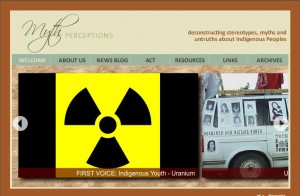“New survey sheds light on cultural stereotypes”
Reginald Bibby from the University of Lethbridge (my old school) has released the findings of his research study concerning Aboriginal teenagers. Unfortunately, the entire study is not available online for free. However, I was able to find a summary of the findings written by the author at http://www.edmontonjournal.com/business/fp/Young+aboriginals+true+colours+same+ours/3662136/story.html
There are some interesting things in it, especially in the light of the interview with Amy Parent that we studied.
The summary of the article states that young Native people are very similar to the general population. The article then goes on to state the differences, which include a much greater spirituality. The survey also states a similar finding about technology.
In the light of the Returning to Gitxaata video, it’s also important to note that the research has been released for sale privately, or in summarized form in newspapers. It was touching to see the response of the people when the UBC team returned with their research. Unfortunately, this did not happen in this case. While the nature of the research was different, surveying a demographic across different nations, it still would have been nice to see an attempt to bring the results to the people concerned.
October 14, 2010 No Comments
Native Networks
The Native Networks website is related to the National Museum of the American Indian. The Museum is part of the Smithsonian institute.
Native Networks, in their words, “. . . is dedicated to presenting and disseminating information about the work of Native Americans in media.
. . . Native Networks Website has four goals:
To provide a representation of current work in the field of Native American media including film, video, radio, television and new media.
To provide information to the public about the outstanding media productions which have been presented in the museum’s programs.
To provide the FVC and NMAI a way to maintain regular and frequent contact with the community of Native American independent media producers.
To provide a space for Native media makers to exchange ideas and to gather professional information.”
The site tends to view all First Nations people as a homogeneous group. There are no distinctions made for specific tribes, or even between north and south American Native peoples.
Resources include information about the Native American Film and Video Festival, plus links to other media related sites involving radio, film, video, other film festivals, and distributors.
http://www.nativenetworks.si.edu/nn.html
October 13, 2010 No Comments
Kiviaq vs. Canada
The most recent grade eleven program of study created for social studies in Alberta deals with the concept of nationalism. Like other high school level social studies courses, the new curriculum includes a much greater focus on First Nations issues than what had been included in the past.
Quoting from the program of studies:
“Students will . . . evaluate the importance of reconciling contending nationalist loyalties (Canadian nationalism, First Nations and Métis nationalism, ethnic nationalism in Canada, civic nationalism in Canada, Québécois nationalism, Inuit perspectives on nationalism)”
http://education.alberta.ca/media/774373/soc20.pdf
A great resource that I have found is the movie Kiviaq vs. Canada. The film is a documentary from filmmaker Zacharias Kunuk. The subject of the film, Kiviaq is an Inuit man who was moved to Edmonton as a boy. He discusses his life and in the process gives great insight into the concept of nationalist loyalty, marginalization, and assimilation. Kiviaq was given the name David Ward by his father, and grew up boxing, playing football (ironically for a period for the Edmonton Eskimos), and working as an alderman and radio host. Later in life, he went back to school and became a lawyer. The film also examines his legal battles to be recognized by his Inuit name, and the challenges to have the Inuit receive similar funding as other First Nations people in Canada. The McGraw-Hill Ryerson textbooks for Social Studies 20-1 and 20-2 each have a short section dedicated to the story.
In the context of ETEC 521, the film is a great example of Aboriginal film makers using the media to illuminate an issue. This is not presented as a movie about Inuit issues. The issues become clear through an examination of the subject, Kiviaq.
http://www.isuma.tv/hi/en/isuma-productions/kiviaq-vs-canada
September 30, 2010 No Comments
MythPerceptions
Myth Perceptions is a site that I came across that might help people understand First Nations culture better. Many people (not necessarily those taking this course) but cultural misconceptions and stereotypes exist (regardless of the culture). This site provides information to demystify those ideas. It also presents issues that First Nations people face.
September 19, 2010 No Comments

